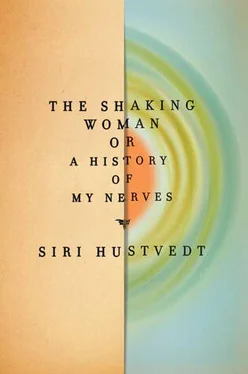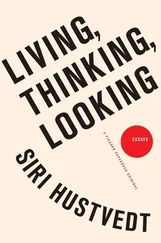Again, it’s important to note that not all split-brain patients have hands with lives of their own, only some. Even when people have similar lesions or commissuritomies, the damage or cut cannot infallibly predict symptoms, which means that a purely anatomical investigation will not provide an answer to why this happens. What is, in fact, most remarkable about split-brain people isn’t their deficits but how few problems they seem to have. Of course, these surgeries do not cut the entire nervous system in half. The brain stem is not severed, so some communication remains between the two sides. Brains are also plastic and adaptive to changed circumstances. Younger brains are more malleable than old ones. An infant who loses an entire hemisphere of his brain can grow up to be astonishingly normal. A child who loses his sight early is far more adaptable than an adult who goes blind; the areas of the brain devoted to vision will be remapped for the other senses, especially auditory functions. Brains can reroute themselves, and it now appears that although plasticity decreases as we grow older, it never stops. All the split-brain patients studied retained a strong sense of an “I” and a working left-brain interpreter, even when that interpreter was wrong about what had been seen by the right hemisphere. Their linguistic functions worked perfectly.
“I” exists only in relation to “you.” Language takes place between people, and it is acquired through others, even though we have the biological equipment necessary to learn it. If you lock a child in a closet, he will not learn to speak. Language is outside us and inside us, part of a complex dialectical reality between people. Words cross the borders of our bodies in two directions, outside in and inside out, and therefore the minimal requirement for a living language is two people. The first time I encountered a language for two was in a pair of identical twins in my hometown. The girls were about three when their parents noticed that they communicated in a dialect all their own. F. and T. grew up in a bilingual family — French and English — and seemed to have looted bits and pieces of both languages to create a peculiar hybrid of their own. In the 1930s, the Russian neurologists A. R. Luria and F. Yudovich did a study on two brothers, six-year-old identical twins who, like F. and T., had developed their own language, based on gestures and some primitive nouns. The boys showed significant cognitive and developmental delays in every area. The neurologists separated the twins and, in rather brutal Soviet style, decided to give language lessons to only one of them: Twin A, the underling of the duo. Twin A quickly outstripped his brother, Twin B, in language skills. He began to speak in sentences with verb tenses and syntax, and he developed an imagination — that is, he was able to project himself into the future and remember himself in the past. He also gained the ability to understand nonverbal games that had eluded him earlier. Before he acquired the necessary linguistic tools, he couldn’t understand formal games, didn’t know what to do with balls thrown to him or where to run or jump. Learning Russian ordered his mind in an entirely new way. 54Luria did not articulate this as I would, but human time, essential to working consciousness and, of course, storytelling, may well arrive through language.
After an infant’s birth, the brain’s prefrontal cortex develops enormously in two big spurts around the ages of two and five, and it develops in relation to our experiences with others. Its neurobiology is dependent on what happens beyond it, on the vital exchanges between child and parents. The twins invented their own primitive language, which by its very character interfered with their growing up. Its lack of richness and flexibility — verb tenses in particular — created a world of an ongoing present, the sort of world in which, I suppose, my dog lived. He certainly had a memory that was alerted by cues, even a couple of linguistic ones: walk and his own name, Jack . He could learn all kinds of things — to sit, to pee outside, not to jump up and eat the food on our plates — but I feel confident that he didn’t daydream about the future or long for the past. This is a human capacity that allows for an idea of time as we feel it. It lets us locate events in our lives behind us or in some imagined time ahead. But not all human experiences exist in that autobiographical sequence. If we return to Davoine and Gaudillière, their work with people who have been traumatized, and their declaration that “the past is the present,” it’s possible to understand trauma as a form of speechlessness that is located in an ongoing present. Indeed, they argue that trauma victims live “outside of time.” 55My brief flashback experience is a testament to that fact. It was nonverbal, involuntary, and it was not in the past. It was happening again. The directing, thinking “I” had no part in it. Similarly, my shuddering body felt out of my control, but after a while I seemed able to wait it out, to watch as my rattling limbs slowly calmed themselves. Obviously, there is a disconnection here, one we would have to call psychobiological. The propranolol served to shut the door on the rush that rises up in me through a trigger — death, my father, audience. But did my inner speech, my battle to control the shakes and remain calm, help me subdue them before the propranolol came to the rescue?
Luria argues that speech facilitates “the transition from sensation to thinking, and to the creation of new functional systems. Speech not only gives names to the objects of the outside world; it also distinguishes among their essential properties and includes them in a system of relations to other objects. As a result, man can evoke an image of a particular object and use it in the absence of the original.” 56Freud’s famous fort/da story of his grandson in Beyond the Pleasure Principle illustrates this point. The little boy played a game of disappearance and return with a wooden reel attached to a piece of string. He would throw it, saying fort, gone, and bring it back, joyfully saying da, there. Freud interpreted the game as a way for the child to master absence and presence, his mother’s comings and goings. 57Lacan later emphasized the linguistic or symbolic aspect of the game, words being used to control what is missing. We use symbols, and those symbols give us power over what is no longer there or is yet to come. We organize the past as explicit autobiographical memory, what Antonio Damasio has called “the autobiographical self”; fragments are linked in a narrative, which in turn shapes our expectations for the future. There can be no autobiographical self without language.
It was Bertha Pappenheim, Breuer’s famous hysterical patient known as Anna O., who coined the English term “the talking cure.” For a while she seemed to lose her ability to speak in her mother tongue and lapsed into English. Pappenheim had “an army of hysterical symptoms”: coughing, paralysis, anesthesia, and contractures. She also suffered from what Charcot, Janet, and Freud and Breuer called “double consciousness”; she experienced two selves, one “psychically quite normal,” according to Breuer, and another, which she referred to as her “bad self.” Even while she was very ill, he states, “a keen and quiet observer was, as the patient put it, sitting in some corner of her mind, watching all the mad things go on.” 58The interpreter was present. It just wasn’t able to rein in the demon.
Breuer notes that his patient’s hysterical cough first began when she was sitting near her beloved father’s deathbed and she heard dance music coming from a nearby house. The music triggered a desire to be with the revelers, and after that, every time she heard music “with a strong rhythm,” she reacted with a “ tussis nervosa .” 59Was the doctor right? Did music trigger an implicit memory of Pappenheim’s dying father and her guilt for having wanted to leave him and join the other young people who were free to dance into the night? Can we ever really know? Can talking free a person from symptoms? When I stood in front of that tree, I glanced down at the little plaque on the ground in front of it and read my father’s birth and death dates. Was that my music?
Читать дальше












